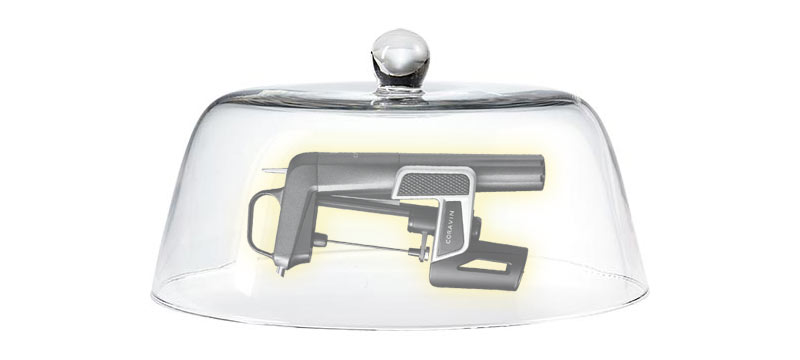The Coravin. This little device has changed the face of wine service and storage massively since its creation in 2011. The act of jabbing a hollow needle through the cork in a wine bottle, injecting argon gas and then letting a small amount trickle out, all in the name of not having to open the bottle is revolutionary. It could be beneficial for the home user who just wants a glass or then the restaurant who can suddenly make their by-the-glass list go boom as seen by the likes of 67 Pall Mall who lay claim to offering 500 wines by the glass.
About a year ago I finally took the plunge and bought one of these wonders, making very steady use of it since. Given all the excitement around it, does the Coravin live up to not only its claims but its usefulness? Yes and no with many varying shades in between. It’s an extremely versatile product and while it fits many uses, it isn’t a one size fits all solution to wine storage. So, let’s have a look at what have been my observations over the last year as well as having had many conversations with people in and out of the wine trade in terms of how much of a “come to Jesus” device this may or may not be.
The Claims
I seem to recall when the Coravin was first launched that they made the claim you could pour off a glass whenever you wanted and the wine would keep vaguely, “forever!” Now all materials seem to say “up to three months”. I have yet to really test that but there is most definitely an upward limit in terms of how long you can store a wine once you tap it with the Coravin. Actually, there’s seems to be a pretty immediate effect that I call “pull shock” and I don’t know if it’s the argon, the punctured and re-sealed cork, or just that the wine has had a chunk of it yanked away and is suffering something akin to bottle shock. Whatever the reason, a wine that’s been tapped definitely tastes “different”.
What do I mean by that? Well, it manifests itself in many different ways. Sometimes it’s barely perceivable and most people wouldn’t notice a difference between a wine tapped and one untapped. Sometimes there’s a slight oxidized aspect to the wine which isn’t enough to be a fault but makes it different and this I usually attribute to the cork. And then there’s just a vague “gaseous” kind of aspect to some wines which I have to assume is the interaction with the argon although given that it’s a noble gas, there shouldn’t be any difference. Maybe it’s some kind of reduction issue as you have effectively created an non-oxygenated layer in the wine once the argon is in place.
It’s also not the case that you can use a Coravin on all corks. Obviously screw caps were out of the question until the Coravin folks released the quite brilliant replacement caps which screw on and can be tapped something like 25 times. I find them a bit expensive and given that most screw caps seem to be the smaller size, they should offer just a pack of six in that size. But otherwise, this is a solid item that’s very much added to the Coravin’s ability.
When it comes to good ole corks, it’s a different story. High-grade corks are no problem as the needle slides in like silk and then the cork seals back up with no issues. Lower-grade corks can be a problem as it can be hard to get the needle in (no jokes please) and then there can be leakage afterwards (fine, jokes if you must.) Fully-synthetic corks are a complete no go as they leak like a sieve. Also on the potential problem list are composite as well as Diam corks. I’ve had extremely mixed results with both of these and I lean towards not using the Coravin on either of them whatsoever.
It’s also important to keep in mind what happens when you pressurize a bottle of liquid that wasn’t originally designed for such things. Most of the time, there’s no issue. Apparently with the Model 1, some bottles could explode but I’ve never heard of anyone having that happen to them so I have to assume it was a pretty rare occurrence. There can be other issue though with wines that have a shitty seal of the cork. One initial gas injection saw a stream of wine shoot out the side of the cork. Another time, a bottle of apparently cheap Madiran had the cork pop out a bit when the gas was a injected. I bring this issues up not as a failing of the Coravin but more to the fact that not all wines are created the same and certain flaws can make for “curious” moments.
The Individual
I’ve met many an individual who will tell me, “Yeah, we bought the Coravin thing but well, we don’t much use it.” For a couple, it makes little sense as a bottle of wine is even better to share between two people than a secret. One evening, two glasses apiece and, as the British say, “Bob’s your uncle”.
There is the use case wherein one in the couple likes reds and the other whites and so one can have one wine and the other, the other. That’s all fine and dandy but if it’s just to have the wine the next day, there are actually better options like those vacuum pump stoppers. For keeping a wine 24-48 hours, they work surprisingly well and I see a lot of wineries who have people come through for regular tastings storing the samples for the next day with them to no ill effect.
Then of course there’s the Eto (update: read full review), a long-delayed Kickstarter project that I even chipped into. The device was even featured on The Wine Show and if it does what it claims to do (as well as what a lot of people in the wine trade have claimed it can do) it will solve this problem perfectly, saving the wine in a perfect state for up to a week it seems. I don’t really understand how it works, but I’ll let you know once I get my hands on one, at some point…
The Trade
For people in the trade, this is a godsend. Wineries are able to offer tastes of their top-end wines. Sales people can do the same at events. And in general, it offers up a method to not burn through nearly as many bottles as in the past which is extremely importantly when you’re talking about limited-production wines of less than 1,000 bottles.
A friend of mine who is a local winemaker at her family winery makes a great deal of use of the Coravin their top-end 200€ a bottle wine so that they can have it available for tastings. It’s a reasonable premise given that’s a price which is a bit of an ask for people to buy solely on a leap of faith (although it is an excellent wine.) Her big beef is that while the system works great, she finds that they burn through a lot of capsules and there is no way to recycle them. In addition to the cost, that’s a lot of environmental impact and while Coravin says that they’re “working on this”, it’s an unfortunate aspect to using them and it’s why both my friends and myself are saving all our capsules for whenever this day of recycle reckoning arrives.
Many have already leaped into the future on this front and invested in the Bottle Thief system which essentially “hot rods” your Coravin to use a standard large argon tank. Not only does this save money, but it saves capsules and if you’re using the device a great deal like another cellar I know, it’s a worthwhile investment even though it costs as much as the Coravin itself initially. But, if you have a bar or restaurant and do a solid by-the-glass selection, this is a gift from the heavens. I’m sure it voids whatever warranty there is on the Coravin (as I’m sure they make a great deal of money on the capsules) but offering an officially-sanctioned version of this at some point might very well be in their interests.
I mention this as while I have neither a winery nor a wine bar, I’ve taken to tasting all bottles I receive as samples using the Coravin and this is thousands of bottles. I think it works out to something like 0.25€ a tasting but for me, it’s worth it as I can potentially save the bottle to taste/enjoy later or give it to friends or even back to the winery if they’d like–I consider myself very fortunate to have an overflowing cellar most of the time. But given how I’m tasting everything in my work cellar, the need to be portable isn’t there and so this “hot rod” system has a good deal of potential appeal to myself as well, both on a cost and an environmental front.
The Wine Student
Even more than the trade, the Coravin is a blessing for anyone studying wine-related things. With any path of study you choose, tasting is a big component and it used to be the fact that you burned through countless bottles as you quizzed yourself on blind tastings or just analyzed various wines each day. The irony in this is that when you’re studying, you’re not really drinking the wines (in theory) and so you’re just tossing good wine as well as good cash into the spittoon.
Perhaps the Coravin has made study groups where you share the costs of buying wines a touch redundant but it has made life a great deal easier as if you don’t live in a top-tiered wine market, you spend a great deal on buying wines but also in time spent trying to find all the damned things.
Choose Wisely
Whether using the the Bottle Thief adapter (which is a bit overkill if you’re not a wine bar or busy cellar) or the capsules, the Coravin has been a massive change for all those looking to better their wine knowledge or get simply get more out of the wines they have at home.
Perhaps there are some more use cases out there that I’ve missed? I feel that this largely covers the main groups, but perhaps there are others and perhaps there are additional options to allow you to slowly suck away at your wine than having it in one lovely, yet fleeting go?
Also, have a look at a review of the latest models.
You’re reading a free article on Hudin.com.
Please consider subscribing to support independent journalism and get access to regional wine reports as well as insider information on the wine world.



